
from Japan vol. 49 2010.03.03 Getting back time with your family - Making Bento Day more widespread!
![]()
- What is "Bento Day" - a day where children make their own lunches?
- Stories behind the movement
- "Bento Day" changes how we spend time at home
- t all started from "appreciation for school lunches"
- Various different approaches are being taken
- Dealing with a "pitiful situation"
- Cultivating the sense of value that "it's cool to try hard"
- Older students help encourage younger students' "power to grow"
- "Bento Day" as a "rite of passage"
- Six dreams encompassed in "Bento Day"
We introduced "Bento Day" or the "box-lunch day" in our book "TABEMONOGATARI". Recently this movement has begun to draw more attention. "Bento Day" has tremendous potential to drastically change the environment, region, and homes children live in. But what is the secret behind it? In this Earth Report, we are featuring an article written by Ms. Miho Watanabe, who has been an advocate of "Bento Day" ever since she reported on this unique movement as a journalist for The Nishinippon Shimbun in 2005.
Back to Table of Contents What is "Bento Day" - a day where children make their own lunches?
Currently, the "Bento Day" initiative is spreading to elementary and junior high schools across Japan. Although there have been schools that had implemented their own "Bento Day," it was usually the parents who made the lunch boxes. What we will be introducing in this report is "Bento Day" where children take the initiative. This means that children do everything from planning the menu, shopping for ingredients, cooking, cleaning up, to packing the food into a lunch box on their own.
The idea originated from Takinomiya Elementary School in the town of Ayagawa in Kagawa Prefecture in 2001. The very first year, a total of 126 students from 5-6 grades who had learned the fundamentals of cooking in domestic science class wanted to challenge themselves by making their own lunch boxes 5 times a year; everyone enjoyed eating their original lunch boxes.
Children prepare their lunch boxes in the kitchen from early morning. It may seem like an easy task, but it is actually quite "hard work" for families nowadays. Mr. Kazuo Takeshita, then principal of Takinomiya Elementary School, says that the PTA (Parent-Teacher Association) members immediately rejected the "Bento Day" idea when he proposed it saying, "I've never let my children touch the gas valve or kitchen knives because it could be dangerous." or "I don't think they can wake up that early." It seems that there were also parents who thought there is no way they can let their children occupy the kitchen at such a hectic time of the day.
However, this year, 9 years after Takinomiya Elementary School first started the movement, the "Bento Day" has begun to spread nationwide. As of the end of November 2009, there are 557 schools including universities in 37 prefectures that are taking part. In Utsunomiya City, the local government has implemented the "Bento Day" at all 93 elementary and junior high schools under its jurisdiction last year; the "Bento Day" takes place a few times a year and approximately 40,000 students take part.
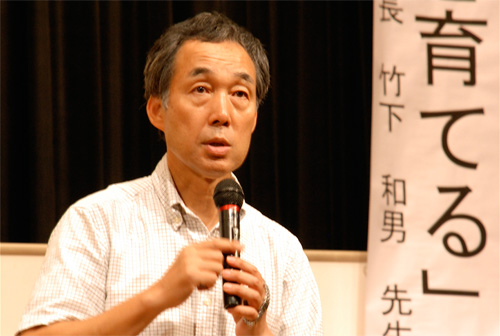 Mr. Kazuo Takeshita, an advocate of "Bento Day".
Mr. Kazuo Takeshita, an advocate of "Bento Day".
Back to Table of Contents Stories behind the movement
So, why are more and more schools starting to adopt "Bento Day," even though it was thought at first to be "hard work"? We had a chance to learn about the various reasons in detail at the first national exchange program organized by Mr. Takeshita, which took place in Kagawa in late October 2009. 140 people who support the idea including 61 locals such as teachers and the town mayor who provided support in carrying out the initiative, PTA members, alumni, and Women's Club members, and 79 people from various educational organizations, governments, and agricultural organizations as well as midwives from all over Japan attended the event. I also took part, too.
At the beginning of the event, Mr. Takeshita shared a great story with us. The theme for the first "Bento Day" conducted by a school in Saga Prefecture was "thank-you lunch box." A girl in 6th grade woke up at 5:00 am and prepared 3 lunch boxes. One for her father who was going back to Osaka where he works during the weekday away from his family; one for her grandmother who was staying in the hospital; and one for herself to bring to school. Her parents, who were told not to help, sat at the dining table and watched her prepare these lunch boxes on her own. After eating the lunch box made by his beloved daughter on the bullet train, the father called his wife during his lunch break from work and said, "Please tell our daughter I said thank you. It was so delicious and made me so happy that I cried while I ate." When her grandmother received the lunch box, she told the mother in a tearful voice, "I have made so many lunch boxes in my life, but this is the first time someone made one for me. It was delicious."
The girl, Michiko Honda, is now a second-year junior high school student. She also took part in the event. She told us with a smile, "Because my family was so happy that I made them lunch, I really enjoy cooking in the kitchen now." Her mother, Emiko, recalls how important it was to trust children and be there for them if they ask for help. "The children are willing to do it on their own and actually they are very capable if we leave them to it. It made me realize that we, adults, were not aware of that fact."
Stories about "Bento Day" such as this one continue to emerge from other schools and homes.The movement has spread because parents, who came to realize that children exhibited the potential for "growth" in the kitchen, changed sides and began to support and encourage "Bento Day."
Back to Table of Contents "Bento Day" changes how we spend time at home
Implementation of "Bento Day" will change how we spend time at home.For example, the family may eat leftovers such as fried eggs or fried chickens made by children for breakfast and there may be more conversation during meals, i.e. talking about how the children cooked the meals. Children may begin to hang around in the kitchen before they get called to the dining table or the children may prepare the meal when their parents are busy or sick.
Ms. Michiko Uchida, a midwife in Fukuoka Prefecture, learned about the movement 3 years ago and has been supporting it ever since to get more children across Japan involved. She shared with us her thoughts about the significance of "Bento Day". "What is common among youths that repeatedly face sexual issues such as STDs, teenage pregnancy, and abortion is lack of communication within the family. Because they feel that they have no place in their home, they seek relationships with others, even with men who only want to get close to them for sex. I believe that "Bento Day" has the power to completely uproot and change such situations." Currently, Ms. Uchida gives lectures on "life" rather than sex education. She always talks about how important the time you spend with your family at home is, as well as about the "Bento Day" initiatives.
Although many have talked about how important family time is for children's growth, it is very difficult to make sure that such "valuable time" is once again part of our lives. "Bento Day" is a tangible measure that helps us get such times back.
Back to Table of Contents It all started from "appreciation for school lunches"
There are some people who ask if this movement is a statement against school lunches. But it is actually completely the opposite.Mr. Takeshita thought of letting children cook their own lunch boxes, so that they will begin to develop a sense of appreciation for school lunches.
When Mr. Takeshita attended a conference held by the school lunch association as the principal of his school, he learned that delivering lunches to schools involved a great number of staff and tremendous effort on their part throughout the process - from food control, menu planning, cooking, to delivery. But he felt that the children lacked appreciation for these people behind the scenes. That is when he thought "Then, let's make the children do everything from choosing the ingredients to cooking on their own" to help raise their awareness.
Children who have experienced "Bento Day" have become aware of "how much work it takes to prepare meals every day." Many of the students began to eat even their least favorite dishes and significant decrease was noted in the amount of school lunch leftovers at Takinomiya Elementary School. Also, at the Kokubunji Junior High School in Takamatsu City, where Mr. Takeshita was transferred to afterwards, and the Ayagami Junior High School in the town of Ayagawa, where he currently works as the school principal, there have been "almost no leftovers" ever since they implemented "Bento Day."
Back to Table of Contents Various different approaches are being taken
At Takinomiya Elementary School, the school principal made a top-down decision with respect to the implementation of "Bento Day," but I learned that each school that participated in the exchange program has implemented their own unique approach that suits their needs.
When Mr. Yoshihiro Imanasu, an elementary school teacher in Fukuoka City, first learned about "Bento Day," he had second thoughts about implementing it at his school. He thought, "I can't make the decision to stop school lunches because I'm not the school principal." When he was considering the possibility of putting "Bento Day" into practice, an idea occurred to him - "Let's use the days students go on excursions or field trips since there won't be regular school lunches anyway."。
Since he taught third grade, which didn't include domestic science class in the curriculum, he proposed a "course-based Bento Day." It let children select a course from the following 4 options (it was named "Imanasu style"): A "perfect course (children prepare lunch boxes alone)," "recommended course (children prepare lunch boxes with help from their parents)," "basic course (children make onigiri [rice balls] and help pack ingredients into the box)" and "entertainment course (children express their appreciation for the person who made the lunch box as much as they can).
On the first excursion day, 95% of his students decided to have a go at either the "perfect course" or the "recommended course." But with each excursion, more and more students began to prepare lunch boxes on their own. Mr. Imanasu said he was impressed when he found students who brought lunch boxes prepared by themselves even on sports day.
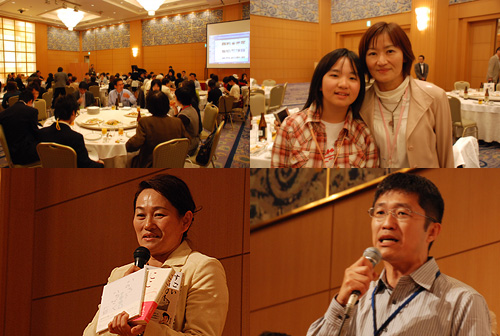 (Upper left) Exchange program attended by people from all over Japan, (upper right) Michiko Honda and her mother; (lower left) Ms. Michiko Uchida, a midwife; (lower right) Mr. Yoshihiro Imanasu, the proponent of the "Imanasu style."
(Upper left) Exchange program attended by people from all over Japan, (upper right) Michiko Honda and her mother; (lower left) Ms. Michiko Uchida, a midwife; (lower right) Mr. Yoshihiro Imanasu, the proponent of the "Imanasu style."
Utsunomiya City, which adopted the "Bento Day" initiative for all students in its elementary and junior high schools, set a goal for every student, which was "to be able to prepare your lunch box all by yourself by the time you graduate from junior high." In other words, the city introduced "Bento Day" as a "9-year plan" to be carried out from elementary to junior high school years.
The "Bento Day" movement, which is gaining popularity among university students, begun from the "potluck lunch box system" proposed by students of the Kyushu University (Fukuoka City). They decide on a theme each time such as "dishes made of ingredient that starts with the same alphabet as your name" or "foods under 100 yen," and students eat each other's lunch boxes on campus. Assistant Professor Goshi Sato who has been supporting the students' "Bento Day" initiative says, "When students start making food for others, they will begin to focus more on the quality of the ingredients rather than low costs. They will also start to look more for local foods and safe foods as much as possible. A country's food self-sufficiency is not something that you raise. It is something that 'rises.'"
The "Bento Day" initiative continues to produce meaningful results because it can be implemented in various different ways depending on the situation.Mr. Takeshita comments, "I'm often asked for advice on how to implement "Bento Day," but only they can find the answer to their question. I believe that the process of finding a way to overcome difficulties is the most important part, so it would be a shame to simply rely on others."
Back to Table of Contents Dealing with a "pitiful situation"
"At some homes, parents don't cook. Wouldn't "Bento Day" be cruel to those children?" Such concern may be an obstacle to implementing the idea. But Mr. Takeshita says,"It would be much worse to leave them in such a pitiful situation. If the parents can't cook, why not help teach the children how to cook on their own? It will be something they can cherish over a lifetime and parents would appreciate it, too."
At the exchange program, I had the opportunity to hear about personal experiences that well paint what we can expect to see in the future. Ms. Kayoko Mizusawa, a school clerk at Ayagami Junior High School, was brought up by her mother who imposed very strict rules when it came to chores. She and her 2 siblings shared the responsibility of preparing breakfast for the family and they were not allowed to eat if they neglected their chores. One day, the day before the high school entrance exam, she asked her mother, "Can I get a break from cooking at least today?" Ms. Mizusawa can still remember how her mother scolded her saying, "You can't take life for granted. You have to do what is necessary to live your life." Her mother passed away during Ms. Mizusawa's last year in high school. Since then, she and her siblings have been running the house smoothly by themselves and she came to appreciate how her mother hand taught them how to cook by themselves. "I feel very fortunate to have learned how to cook. I appreciate what my mother has done for us and, now that I have become a mother myself, I am teaching my children the same lesson."
At the meeting participants earnestly discussed what adults should really do in order to protect children.
Back to Table of Contents Cultivating the sense of value that "it's cool to try hard"
On the next day of the meeting, I went to sit in on "Bento Day" held at Ayagami Junior High School (a total of 135 students) where Mr. Takeshita currently works as the school principal. The teachers brought their own lunch boxes, too. In one classroom a teacher was taking photos of each lunch box made by the students of the class, while in another classroom, a teacher was taking a group photo of all her students' lunch boxes together. The entire school seemed to be filled with excitement. Some students were peering into the box before opening the cover while some answered with a shy smile when a friend asked if they could exchange some food.The children seemed to be more excited and filled with anticipation than at regular school lunch time.
None of the teachers asks if the children actually prepared the lunch boxes on their own. Some parents help their children even if the children want to cook on their own, but the school doesn't think that it's important to know the truth. The classmates would know whether other students have actually made the lunches by themselves or not when they talk to them or when they watch their reactions. If there are any students who didn't cook their lunch on their own, they would think that the classmates who made theirs alone are cool and would regret not having done so themselves. Then, they would secretly promise to prepare their lunch alone next time. "It's cool to try hard." "It's cool to stand on one's own feet." I felt that such values were being nurtured at the school.
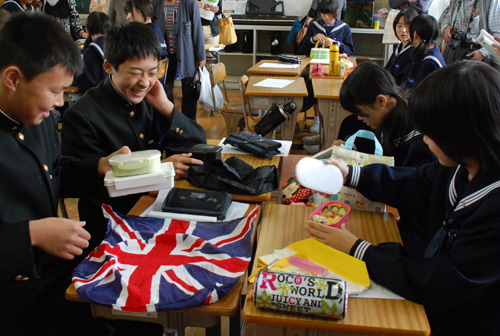 The moment students open their lunch boxes is really exciting. (Ayagami Junior High School)
The moment students open their lunch boxes is really exciting. (Ayagami Junior High School)
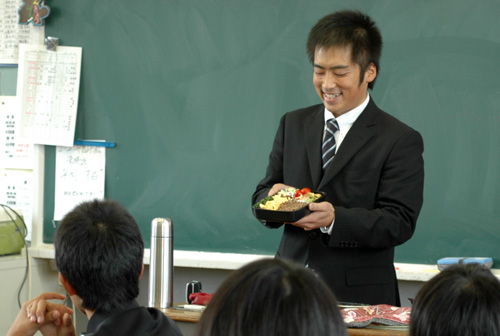 The teachers also bring lunch boxes. Both teachers and students have big smiles on their faces! (Ayagami Junior High School)
The teachers also bring lunch boxes. Both teachers and students have big smiles on their faces! (Ayagami Junior High School)
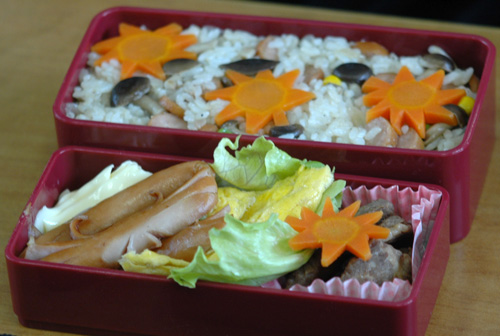 The theme this time was "colorful lunch box." A wide variety of unique and colorful lunch boxes were brought in. (Ayagami Junior High School)
The theme this time was "colorful lunch box." A wide variety of unique and colorful lunch boxes were brought in. (Ayagami Junior High School)


Back to Table of Contents Older students help encourage the "power to grow"
I had a great time at Ayagami Junior High School's "Bento Day". Since I was only there for one day, it is hard to say how the students have grown. But I thought that I caught a glimpse of the students' growth at the student choir contest held in the school gym after lunch.
The annual school festival was being held. Parents, families, and local residents gathered to watch the students perform. The first thing that impressed me was that the students who had gathered in the gym were not whispering to each other. All the students were sitting straight in their seats looking forward. So there weren't any teachers going around disciplining the students. Although it may be the proper way to behave, we rarely see such behavior at elementary and junior high schools nowadays.
I was also amazed by their performance. The second year students sang better than first year students, and third year students better than second year students. All students stood up on stage holding their heads up high. None of them seemed shy or embarrassed; they stood tall. The younger students added energy to the mood by cheering and applauding the third year students while they performed on stage, but everyone quickly went back to their seats and listened quietly once someone started speaking. I was surprised to hear that some of the students couldn't even sit still when they first came to the school.
I thought the "key" to success was included in the closing speech given by Mr. Takeshita. "I was amazed by the third year students' chorus. And the first year and second year students watching the third year students had such beautiful eyes. They may have thought this is what they needed to be like by the time they start their third year." Next year, the first year and second year students will be playing a key role in school activities. I believe that third year students proved themselves great role models for second year students by stimulating their "power to grow."
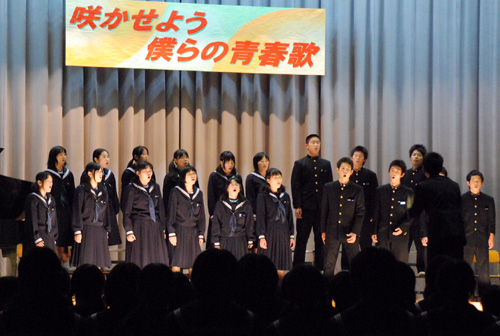 Students in Ayagami Junior High School put on a superb performance with their amazing voices.
Students in Ayagami Junior High School put on a superb performance with their amazing voices.
Back to Table of Contents "Bento Day" as a "rite of passage"
Actually, a similar measure has been adopted at the Takinomiya Elementary School in order to stimulate the children's "power to grow". That is, the "Bento Day - Show and Tell", which was started by Ms. Keiko Suezawa who became the school principal after Mr. Takeshita left. Children in lower elementary grades who still don't make their own lunches look around at the lunch boxes of students in upper grades, right before lunchtime so their stomachs start to growl!
This had a great impact on the younger students. Inspired by the older students, they thought, "I would also like to become a cool fifth grader who can make a delicious lunch box," and began to hang around their parents in the kitchen so they can learn how to cook. After 9 years since its initiation, "Bento Day" has taken root as a "rite of passage" into adulthood and children in the Takinomiya Elementary School are improving their cooking skills year after year.
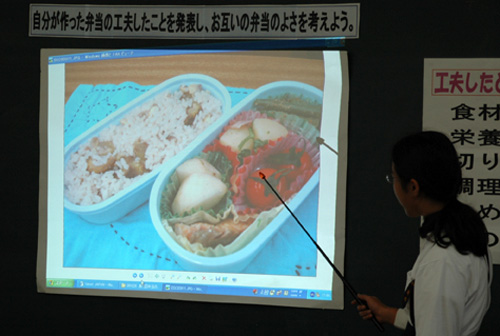 Currently, children in Takinomiya Elementary School present their lunch boxes using large screen TVs.
Currently, children in Takinomiya Elementary School present their lunch boxes using large screen TVs.
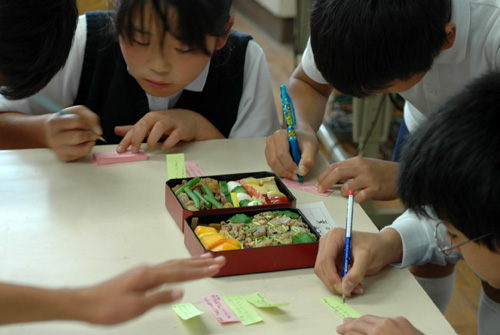 Children write comments on friends' lunch boxes. Teaching styles differ depending on the classroom. (Takinomiya Elementary School)
Children write comments on friends' lunch boxes. Teaching styles differ depending on the classroom. (Takinomiya Elementary School)
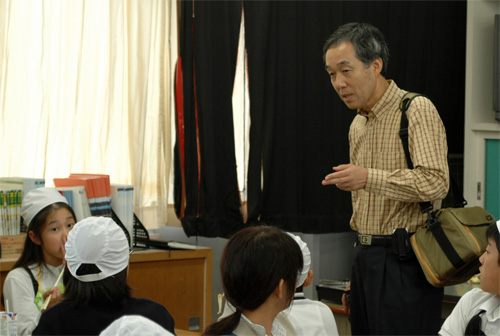 Mr. Takeshita talk to children eating their lunch boxes. (Takinomiya Elementary School)
Mr. Takeshita talk to children eating their lunch boxes. (Takinomiya Elementary School)
Back to Table of Contents Six dreams encompassed in "Bento Day"
"I believe that if we can pass down the 'DNA' of a 'good fun family meal' to children, it may continue to be passed down to children 100 years from now." Mr. Takeshita hopes to transform the environment in which Japanese children are raised in through the "Bento Day" initiative.Lastly, I'd like to share the "6 dreams encompassed in Bento Day" that also touches upon this "DNA" that Mr. Takeshita would like to pass down to the next century.
If we recognize that there are difficulties and uncertainties present in the society we live in today, it is the adults' obligation to help nurture the next generation, so that they will not have to experience the same issues. Mr. Takeshita would like to change the future of Japan by getting kids into the kitchen, and he would like to get more and more adults that will help the children who are right in front of them to join this movement. By doing so, I believe that the "DNA" will continue to be relayed from people to people and, eventually, become the power that will open up a new future for many around the world.
Author profile
Miho Watanabe
Joined The Nishinippon Shimbun in 1997. Member of the "Shokutaku no mukougawa (Beyond the dining table)" team since 2003. Her work as a reporter made her reexamine her own dietary habits and improved her physical condition. She left the company in June 2006 to live with her husband who often gets transferred to different regions. Currently, she resides in Tokyo and works as a contributing writer for the Nishinippon Shimbun as well as a freelance writer.
Reported and orginal Japanese text written by: Miho Watanabe
Translated by: Yuri Morikawa (oxygen inc.)
Photographs by Miho Watanabe
Cooperation: Kazuo Takeshita
Photograph cooperation: Soichi Ueda(Think the Earth Project)















